 Society
Society

Tens of thousands of soldiers in the Vietnamese Volunteer Army sacrificed their lives fighting the Khmer Rouge regime in Cambodia. Their remains still lie scattered across the country.
Two search and recovery teams, K70 (under Military Region 7) and K71 (under the Military Command of Tây Ninh Province), have tirelessly combed through former battlefields, hoping to bring the remains of these heroes home.
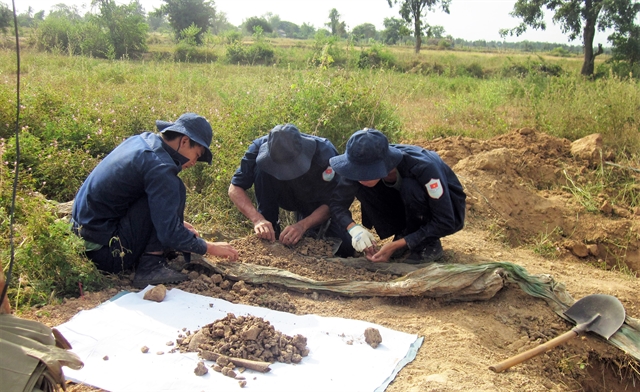 |
| Three K70 members carefully collect bone fragments of a fallen soldier from an excavation site. — VNA/VNS Photo Hoàng Anh Tuấn |
Focusing on five Cambodian provinces – Banteay Meanchey, Oddar Meanchey, Siem Reap, Kampong Cham, and Tbong Khmum – once the hotspots of the war, the teams faced gruelling conditions.
They had to trek through dense forests, ford rivers, and scale mountains in the search for fallen soldiers. They also encountered dangers at every turn, from unexploded bombs and landmines to the lingering effects of chemical warfare.
The Cambodian scorching 2023-24 dry season, with temperatures soaring into the high 30s - 40s Celsius, added to their hardship during the teams' mission of searching, recovering and repatriating remains of Vietnamese servicemen fallen in action in the Cambodian battlefields (Phase 2) .
However, with crucial information provided by Cambodian local residents the teams have found and repatriated 172 sets of remains of Vietnamese war martyrs over the past four months.
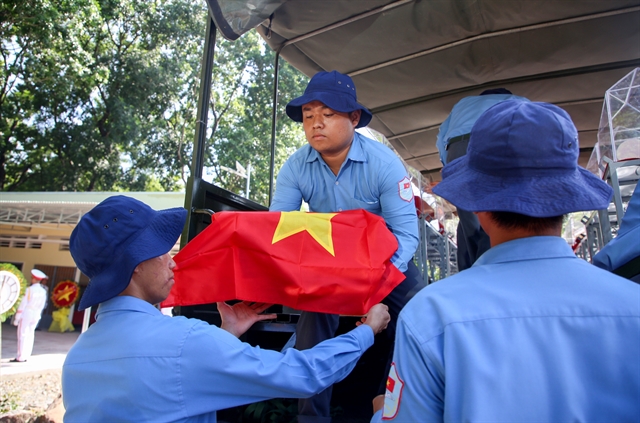 |
| Team K71 members bring the remains of fallen soldiers to Hill 82 Martyrs Cemetery in Tân Biên District, Tây Ninh Province, for burial.— VNA/VNS Photo Giang Châu Phương |
"The conditions were harsh," said a Team K71 member. "The heat, the terrain, and the emotional toll of finding remains of fallen soldiers in such a state were overwhelming. But I am eternally grateful to those who sacrificed their lives for our cause."
Nguyễn Đức Thuận, Team K71 leader, said: "The search and recovery of the war martyrs is a sacred mission; it felt like reuniting with lost family."
Building rapport with local Cambodians is a game-changer for the search teams. By providing medical aid and helping with community projects, teams K70 and K71 have earned their trust and cooperation, leading to countless discoveries.
A K71 team member recalled a breakthrough in a search session in Memot District, Kampong Cham Province in 2015 (in the mission Phase 1). After days of fruitless digging and facing dwindling water supplies, the team sent members on a 10-kilometre trek to find a water source.
They discovered an elderly man injured by a wild boar on the way. After treating his wounds, they struck up a conversation. The man showed him the location of several hidden graves. Guided by him, the team unearthed eight identifiable sets of remains within hours.
This experience underscores the importance of human connection in identifying potential graves. According to K71, roughly 80 per cent of their successful recoveries are due to information provided by local residents.
The remains of the 172 soldiers found by K70 and K71 were returned to Việt Nam via the Xa Mát International Border Gate in Tân Biên District, Tây Ninh Province, on June 28.
They will be moved to the Hill 82 Martyrs Cemetery in Tân Biên and lie in state until the official burial ceremony on July 27 -- the 77th anniversary of War Martyrs Day.
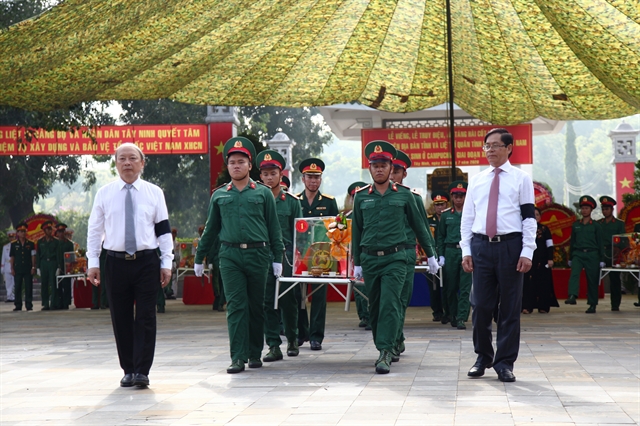 |
| The burial ceremony for the remains of fallen soldiers found in Cambodia at the Hill 82 War Martyrs Cemetery in 2020. — VNA/VNS Photo Vũ Tiến Lực |
Immediately upon returning to Việt Nam, both teams began vehicle maintenance, enhancing Khmer language proficiency, and improving their search and recovery capabilities to prepare for the 2024-25 campaign.
Another dedicated team is K72, under the Military Command of Bình Phước Province. For over two decades, they’ve been operating in Kratie and Kampong Thom provinces, bringing home the remains of more than 2,800 Vietnamese soldiers.
The team has covered thousands of kilometres, braving dense forests, fast-flowing rivers, and arduous digging conditions, with malaria a constant threat.
The harsh conditions often left them dehydrated, sometimes forcing them to resort to desperate measures like eating leaves or purifying swamp water with alum to quench their thirst.
Sergeant Nguyễn Đăng Kiệm of Team K72 described the gruelling conditions his team faced: "We're mainly digging by hand in some of the toughest terrain imaginable," he said.
"Dense forests, steep mountains, and the fast-flowing rivers make searching missing soldiers incredibly challenging. Many graves are unmarked, leaving us with hesitation to go on."
Despite the hardships, Kiệm felt deep satisfaction in his work, saying that discovering the remains of a fallen soldier is like finding a lost family member. That powerful emotion drove him forward in the face of difficulties.
"Finding those remains is like a shot of energy," Kiệm said. "It reminds us why we're here and fuels our commitment to bringing our comrades home."
Private Nguyễn Văn Long of K72 was a newcomer to the search team. Initially unsure of what to expect, he quickly became dedicated to the duty, inspired by his fellow soldiers.
"This isn't just a job; it's a deeply personal mission," Long said. "The challenges are immense, but our commitment to bringing the remains of our heroes home is unwavering."
With the help of Cambodian locals, K72 has pinpointed 225 potential gravesites in Kratie and 63 in Kampong Thom. Last year, they brought home the remains of 172 soldiers.
Like K70 and K71, Team K72 members found that building ties with Cambodian locals is essential to their mission. A K72 member recalled a particularly challenging excavation in 2017.
Using information provided by a Vietnamese war veteran, the team identified a potential gravesite in Ou Ruessei Commune, Kratie Province. However, the construction of a school at the site was nearing completion, and the Cambodian building contractor was adamantly opposed to the team's exhuming work.
Faced with the contractor's refusal, K72 sought help from the deputy military commander of Kratie. Through his mediation and persuasion, the contractor changed his mind. They finally reached a compromise: the team could excavate but only at night.
Equipped with lights and excavation equipment, K72 began the painstaking task. Working under the constraints of nighttime, limited space, and the pressure to preserve the building, the excavation was incredibly challenging.
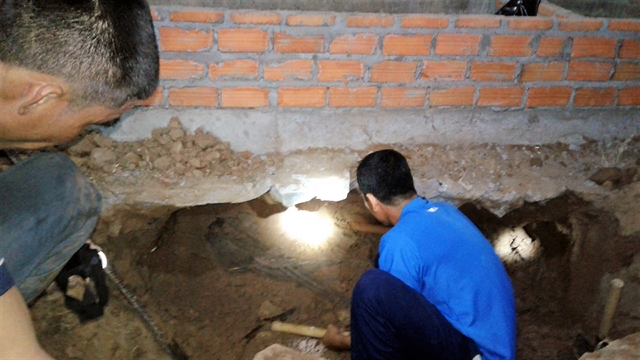 |
| Team K72 members search for the remains of fallen soldiers under the foundation of a school under construction in Cambodia in 2017. — VNA/VNS Photo Hoàng Anh Tuấn |
The team had to be meticulous, carefully removing soil and handling the remains with utmost care. Many of the remains were severely decomposed, making identification difficult.
To make matters worse, some remains found beneath the building were incomplete due to construction damage. Despite the difficulties, K72 recovered remains of 64 fallen soldiers in 28 gruelling days.
The remains of 130 other fallen soldiers were returned to Việt Nam on July 18. Brought back by Team K73, under the Military Command of Long An Province, the war martyrs will be laid to rest in their homeland.
Since its formation in 2001, the team has recovered more than 2,500 sets of remains and uncovered six mass graves, burying about 280 soldiers.
One of the team's founding members, Đỗ Quốc Tiến, recalled a particularly heartbreaking moment. A mother's anguished cries echoed through the Cambodian forest as she searched alongside the team for her son.
In 2005, determined to find his remains, Nguyễn Văn Cũ's mother travelled from Bến Cầu District, Tây Ninh Province, to Cambodia.
Guided by veterans, she joined the team in the remote Thmei Hamlet, Chrey Thum Commune, Romeas Haek District, Svay Rieng Province. After days of fruitless searching, the heartbroken woman cried out for her son's soul to return home.
Her anguish inspired the team to redouble their efforts. They meticulously searched the entire village day and night, leaving no stone unturned. Their perseverance paid off when they finally discovered Cũ's remains and returned them to his family in 2010.
Overwhelmed with emotion, the mother embraced the coffin, her grief palpable. She expressed gratitude to the team for reuniting her with her son and said she could finally find peace knowing his remains were on Vietnamese soil.
In a final wish, she asked to be buried beside her son, expressing her enduring love and longing.
Tiến also mentioned a woman, Nguyễn Thị Chinh in Hải Phòng City, who had searched for her missing husband for decades to no avail.
Her life changed one evening while watching television. A documentary about Team K73 ignited a spark of hope. Determined to find her husband Nguyễn Ngọc Chân, Chinh travelled to the south to join the search.
It would be a gruelling journey, spanning three harsh years before she would finally discover his remains buried in Cambodian soil.
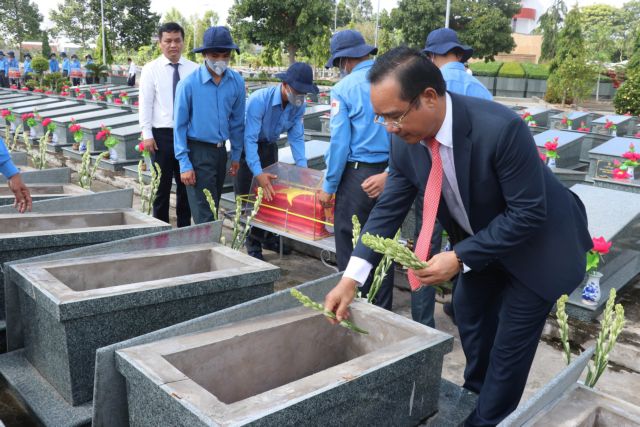 |
| Long An's Party Committee Secretary Nguyễn Văn Được performs the burial ceremony for the remains of fallen soldiers found by K73 at the Vĩnh Hưng - Tân Hưng War Martyrs' Cemetery in Vĩnh Hưng District, Long An Province, in 2022. — VNA/VNS Photo Bùi Như Trường Giang |
Identifying remains of fallen soldiers after decades underground is an immense challenge. As a result, the vast majority - around 90 per cent - of those recovered by K73 remain unidentified.
A few lucky breaks have led to identifications. Some names were found in penicillin vials attached to the soldiers, such as the case of Nguyễn Đức Xây and Nguyễn Bá Quý. Other clues also came from personal items like a snakebite remedy bottle marked with a date or a water bottle engraved with the soldier's name.
DNA technology has revolutionised the identification of unnamed fallen soldiers in recent years. For example, between 2017 and 2018, Tây Ninh Province successfully identified 65 soldiers through DNA testing of the 660 sets of remains.
 |
| A technician at the Institute of Biotechnology extracts DNA from a bone sample to identify an unknown soldier. — VNA/VNS Photo Nguyễn Anh Tuấn |
In 2010 and 2011, a nationwide trend emerged of families hiring psychic mediums to locate the graves of fallen soldiers. Many families spent big sums of money hiring those people on search trips across the country, even as far as Cambodia.
Unfortunately, the information provided by psychic mediums proved to be almost entirely unreliable. Team K71 analysed 200 DNA samples from bones exhumed based on psychic tips, but only one was confirmed of human.
Though the war ended decades ago, its scars remain. Thousands of Vietnamese volunteer soldiers who sacrificed their lives in Cambodia are yet to return home. Driven by the enduring hope of grieving families, search teams continue their sacred mission to bring these fallen heroes back to their homeland. VNS